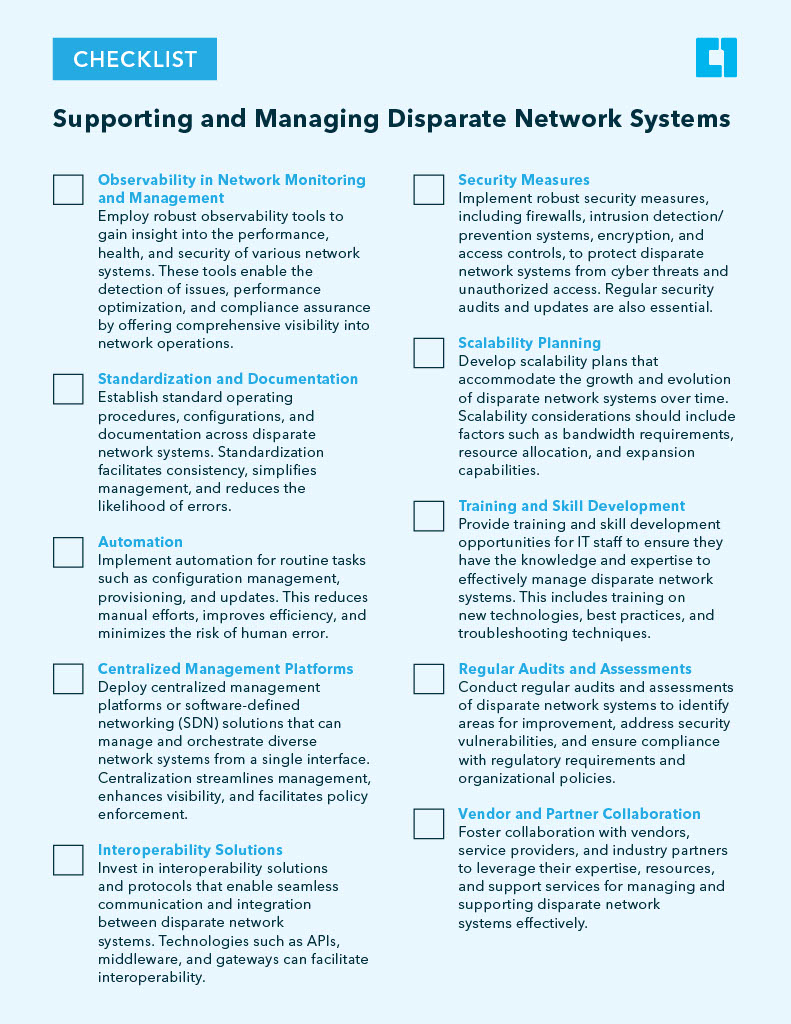Administrators are faced with the formidable challenge of managing and supporting the disparate network systems that comprise many organizations' infrastructure today.
Today's modern infrastructure has grown significantly more complex. But, organizations haven’t had the luxury of replacing the old infrastructure with a shiny new one. Instead, current architectures are generally comprised of distributed networks, varying technologies and platforms and myriad interconnected devices and services that span across varying parts of the organization. Administrators are faced with the formidable challenge of keeping everything patched and updated, preventing network and application performance from interfering with employee productivity, all while trying to protect the company’s data across organization and personal networks.
What is a disparate network? So glad you asked. For this post's purposes, disparate network systems refer to a collection of diverse and potentially incompatible network infrastructures, technologies, or components within an organization or across multiple organizations. These systems may vary in terms of hardware, software, protocols, standards, and configurations. Effectively managing and supporting them is critical to organizations seeking to maintain seamless operation and maximize efficiency yet modernizing them is often not a strategic priority or in the budget.
Examples of disparate network systems include:
- Legacy systems: Older network technologies or equipment that may use outdated protocols or lack compatibility with modern systems.
- Vendor-specific systems: Networks composed of equipment and technologies from different vendors, each with its own proprietary standards and configurations.
- Hybrid cloud environments: Networks that incorporate both on-premises infrastructure and cloud-based services from multiple providers, potentially leading to integration challenges.
- Branch office networks: Networks in geographically dispersed locations, each with its own unique infrastructure and connectivity requirements.
- Mergers and acquisitions: Organizations that have undergone mergers or acquisitions may inherit disparate network systems from different entities, requiring integration efforts – which often don’t get done according to integration plans.
Managing and supporting disparate network systems is challenging due to the need to ensure interoperability, security, performance, and compliance across diverse environments. The challenges and complexities inherent in managing and supporting disparate network systems can significantly impact businesses, ranging from increased operational costs and decreased productivity to heightened security risks and compromised customer experiences. Challenges include:
- Interoperability: Different network systems may use varying protocols, standards, and technologies, making it difficult for them to communicate effectively with each other. Ensuring interoperability between these systems requires careful configuration and integration efforts.
- Complexity: Managing a diverse set of network systems can be complex, particularly when dealing with a combination of legacy and modern technologies. The complexity increases as the number of disparate systems grows, leading to higher chances of misconfiguration and errors.
- Security: Disparate network systems may have different security vulnerabilities and requirements. Managing security across these systems necessitates implementing consistent security policies, ensuring regular updates and patches, and monitoring for potential threats and breaches.
- Scalability: As network infrastructure expands or evolves, accommodating scalability becomes crucial. Managing disparate systems while ensuring scalability requires careful planning and resource allocation to meet current and future demands effectively.
- Performance: Ensuring optimal performance across disparate network systems can be challenging, especially when dealing with varying traffic patterns, bandwidth requirements, and latency issues. Monitoring and optimizing performance parameters become essential to maintain network efficiency.
- Resource Management: Different network systems may have varying resource utilization patterns and requirements. Effectively managing resources such as bandwidth, storage, and computing power across these systems is crucial to avoid bottlenecks and ensure optimal performance.
- Configuration Management: Consistently managing configurations across disparate network systems can be challenging, especially when changes need to be implemented across multiple platforms. Implementing automated configuration management tools and practices can help streamline this process.
- Monitoring and Troubleshooting: Monitoring the health and performance of disparate network systems and troubleshooting issues can be complex. Implementing comprehensive monitoring tools and practices, as well as having skilled personnel to analyze and address issues promptly, is essential to maintain network reliability.
- Cost Management: Supporting and managing disparate network systems can incur significant costs, including hardware, software, maintenance, and personnel expenses. Optimizing costs while meeting operational requirements requires careful planning and resource allocation.
- Compliance and Governance: Ensuring compliance with regulatory requirements and internal governance policies across disparate network systems is essential, particularly in highly regulated industries. Implementing consistent policies, procedures, and auditing mechanisms can help mitigate compliance risks.
However, it is not all doom and gloom. There are effective management practices that can help overcome these challenges. Successfully addressing these challenges requires a strategic approach. It requires a combination of technical expertise, effective management practices, and appropriate tools and technologies to ensure the reliable and secure operation of disparate network systems.
Many administrators are so focused on keeping the network running that they seldom have time to research and evaluate new ideas for modernizing the network. To make the research easier, here’s a checklist of best practices you can use that quickly identify ways to simplify the complexity of managing an infrastructure built on disparate network systems:

Like every journey, it starts with the first step. Begin your disparate network system management simplification journey by starting with just one topic that starts to enhance the efficiency, reliability, and security of disparate network systems while materially reducing the challenges associated with their management and support.
One of the most effective processes to solve manageability and support of disparate network systems is observability. Observability provides the means to proactively address issues before they escalate by taking advantage of its real-time monitoring capabilities. Administrators will benefit from end-to-end visibility across their entire network infrastructure, even in the most disparate of cases, that will allow them to identify dependencies, pinpoint bottlenecks, and troubleshoot issues across disparate systems more effectively. There are several other key advantages gained by leveraging observability to solve the complexities of disparate systems. To better understand the importance of observability and how it applies, please view our in-depth white paper “Observability and Supporting Disparate Network Systems” found here.




